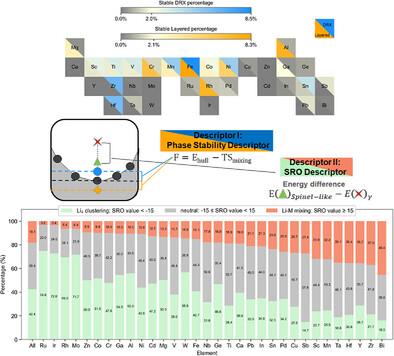Tailored Ordering Enables High-Capacity Cathode Materials
IF 26
1区 材料科学
Q1 CHEMISTRY, PHYSICAL
引用次数: 0
Abstract
Novel Li-ion battery cathode materials with high capacity and greater compositional flexibility are essential for the growing electric vehicle market. Cathode structures with cation disorder were once considered suboptimal, but recent demonstrations have highlighted their potential in Li1 + xM1 − xO2 chemistries with a wide range of metal combinations M. By relaxing requirements of maintaining ordered Li diffusion pathways, countless multi-metal compositions in LiMO2 may become viable, aiding the quest for high-capacity cobalt-free cathodes. A challenge presented by this freedom in composition space is designing compositions that possess specific, tailored types of both long- and short-range orderings, which can ensure both phase stability and Li diffusion. Ordering design frameworks are proposed based on computational ordering descriptors, which in tandem with low-cost heuristics and elemental statistics can be used to simultaneously achieve compositions that possess favorable phase stability as well as configurations amenable to Li diffusion. Utilizing this computational framework, accompanied by illustrative synthesis and characterization experiments, we not only demonstrate the design of LiCr0.75Fe0.25O2, showcasing initial charge capacity of 234 and 320 mAhg−1 in its 20% Li-excess variant Li1.2Cr0.6Fe0.2O2, but also present the elemental ordering statistics for 32 elements, informed by one of the most extensive first-principles studies of ordering tendencies.

订制高容量正极材料
具有高容量和更大组成灵活性的新型锂离子电池正极材料对于不断增长的电动汽车市场至关重要。具有阳离子无序的阴极结构曾经被认为是次优的,但最近的演示强调了它们在具有广泛金属组合m的Li1 + xM1−xO2化学中的潜力。通过放松对维持有序Li扩散途径的要求,LiMO2中的无数多金属成分可能变得可行,有助于寻求高容量无钴阴极。这种组合物空间的自由提出了一个挑战,即设计具有特定的、量身定制的长程和短程顺序的组合物,以确保相稳定性和Li扩散。提出了基于计算排序描述符的排序设计框架,该框架与低成本启发式和元素统计相结合,可以同时获得具有良好相稳定性和适合Li扩散的构型的组合物。利用这一计算框架,结合说明性合成和表征实验,我们不仅展示了LiCr0.75Fe0.25O2的设计,在其20%锂过量的Li1.2Cr0.6Fe0.2O2中显示了234和320 mAhg−1的初始电荷容量,而且还展示了32种元素的元素有序统计,这是最广泛的有序趋势的第一性原理研究之一。
本文章由计算机程序翻译,如有差异,请以英文原文为准。
求助全文
约1分钟内获得全文
求助全文
来源期刊

Advanced Energy Materials
CHEMISTRY, PHYSICAL-ENERGY & FUELS
CiteScore
41.90
自引率
4.00%
发文量
889
审稿时长
1.4 months
期刊介绍:
Established in 2011, Advanced Energy Materials is an international, interdisciplinary, English-language journal that focuses on materials used in energy harvesting, conversion, and storage. It is regarded as a top-quality journal alongside Advanced Materials, Advanced Functional Materials, and Small.
With a 2022 Impact Factor of 27.8, Advanced Energy Materials is considered a prime source for the best energy-related research. The journal covers a wide range of topics in energy-related research, including organic and inorganic photovoltaics, batteries and supercapacitors, fuel cells, hydrogen generation and storage, thermoelectrics, water splitting and photocatalysis, solar fuels and thermosolar power, magnetocalorics, and piezoelectronics.
The readership of Advanced Energy Materials includes materials scientists, chemists, physicists, and engineers in both academia and industry. The journal is indexed in various databases and collections, such as Advanced Technologies & Aerospace Database, FIZ Karlsruhe, INSPEC (IET), Science Citation Index Expanded, Technology Collection, and Web of Science, among others.
 求助内容:
求助内容: 应助结果提醒方式:
应助结果提醒方式:


